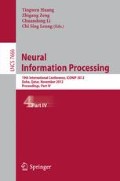Abstract
An approach to the word sense disambiguation (WSD) relaying on the WordNet synsets is proposed. The method uses semantically tagged glosses to perform a process similar to the spreading activation in semantic network, creating ranking of the most probable meanings for word annotation. Preliminary evaluation shows quite promising results. Comparison with the state-of-the-art WSD methods indicates that the use of WordNet relations and semantically tagged glosses should enhance accuracy of word disambiguation methods.
Access this chapter
Tax calculation will be finalised at checkout
Purchases are for personal use only
Preview
Unable to display preview. Download preview PDF.
References
Banerjee, S., Pedersen, T.: An Adapted Lesk Algorithm for Word Sense Disambiguation Using WordNet. In: Gelbukh, A. (ed.) CICLing 2002. LNCS, vol. 2276, pp. 136–145. Springer, Heidelberg (2002)
Collins, A., Loftus, E.: A Spreading-Activation Theory of Semantic Processing. Psychol. Rev. 82, 407 (1975)
Duch, W., Matykiewicz, P., Pestian, J.: Towards Understanding of Natural Language: Neurocognitive Inspirations. In: de Sá, J.M., Alexandre, L.A., Duch, W., Mandic, D.P. (eds.) ICANN 2007. LNCS, vol. 4669, pp. 953–962. Springer, Heidelberg (2007)
Duch, W., Matykiewicz, P., Pestian, J.: Neurolinguistic Approach to Natural Language Processing with Applications to Medical Text Analysis. Neural Netw. 21, 1500–1510 (2008)
Kehagias, A., Petridis, V., Kaburlasos, V.G., Fragkou, P.: A Comparison of Word and Sensebased Text Categorization Using Several Classification Algorithms. J. Intell. Inf. Syst. 21, 227–247 (2003)
Korytkowski, R., Szymaňski, J.: Collaborative Approach to WordNet and Wikipedia Integration. In: The Second International Conference on Advanced Collaborative Networks, Systems and Applications, COLLA 2012, pp. 23–28 (2012)
Kubale, M.: Introduction to Computational Complexity and Algorithmic Graph Coloring, Gdaňskie Towarzystwo Naukowe, Poland (1998)
Liu, H., Singh, P.: ConceptNet: A Practical Commonsense Reasoning Tool-Kit. BT Technol. J. 22, 211–226 (2004)
Lund, K., Burgess, C.: Producing High-Dimensional Semantic Spaces from Lexical Cooccurrence. Behav. Res. Methods 28, 203–208 (1996)
Medelyan, O., Milne, D., Legg, C., Witten, I.: Mining Meaning from Wikipedia. Int. J. Hum-Comput. St. 67, 716–754 (2009)
Miller, G.A., Beckitch, R., Fellbaum, C., Gross, D., Miller, K.: Introduction toWordNet: An On-line Lexical Database. Princeton University Press, New Jersey (1993)
Niles, I., Pease, A.: Towards a Standard Upper Ontology. In: Proceedings of the International Conference on Formal Ontology in Information Systems, pp. 2–9. ACM (2001)
Richardson, S., Dolan, W., Vanderwende, L.: MindNet: Acquiring and Structuring Semantic Information from Text. In: Proceedings of the 17th International Conference on Computational Linguistics, vol. 2, pp. 1098–1102. Association for Computational Linguistics (1998)
Shahaf, D., Amir, E.: Towards a Theory of AI Completeness. In: AAAI Spring Symposium: Logical Formalizations of Commonsense Reasoning, pp. 150–155 (2007)
Solan, Z., Horn, D., Ruppin, E., Edelman, S.: Unsupervised Learning of Natural Languages. Proceedings of the National Academy of Sciences of the USA 102(33), 11629 (2005)
Sowa, J.: Principles of Semantic Networks. Morgan Kaufmann Series in Representation and Reasoning. Morgan Kaufmann, San Mateo (1991)
Turing, A.: Computing Machinery and Intelligence. Mind 59, 433–460 (1950)
Turney, P., Pantel, P.: From Frequency to Meaning: Vector Space Models of Semantics. J. Artif. Intell. Res. 37, 141–188 (2010)
Author information
Authors and Affiliations
Editor information
Editors and Affiliations
Rights and permissions
Copyright information
© 2012 Springer-Verlag Berlin Heidelberg
About this paper
Cite this paper
Szymański, J., Duch, W. (2012). Annotating Words Using WordNet Semantic Glosses. In: Huang, T., Zeng, Z., Li, C., Leung, C.S. (eds) Neural Information Processing. ICONIP 2012. Lecture Notes in Computer Science, vol 7666. Springer, Berlin, Heidelberg. https://doi.org/10.1007/978-3-642-34478-7_23
Download citation
DOI: https://doi.org/10.1007/978-3-642-34478-7_23
Publisher Name: Springer, Berlin, Heidelberg
Print ISBN: 978-3-642-34477-0
Online ISBN: 978-3-642-34478-7
eBook Packages: Computer ScienceComputer Science (R0)

